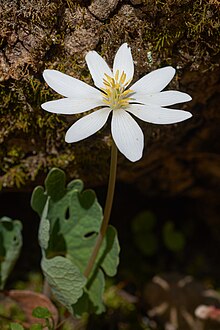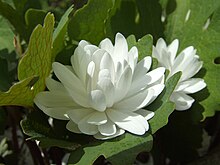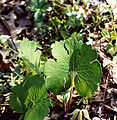Sanguinaria
| Sanguinaria | |
|---|---|

| |
| Scientific classification | |
| Kingdom: | Plantae |
| Clade: | Tracheophytes |
| Clade: | Angiosperms |
| Clade: | Eudicots |
| Order: | Ranunculales |
| Family: | Papaveraceae |
| Subfamily: | Papaveroideae |
| Tribe: | Chelidonieae |
| Genus: | Sanguinaria L. |
| Species: | S. canadensis
|
| Binomial name | |
| Sanguinaria canadensis L.
| |
Sanguinaria canadensis, bloodroot,
Sanguinaria canadensis is sometimes known as Canada puccoon,[4] bloodwort, redroot, red puccoon, and black paste.[3] Plants are variable in leaf and flower shape, and have been separated as a different subspecies due to these variable shapes, indicating a highly variable species.
In bloodroot, the sap is red and poisonous.
Although there are laboratory studies indicating that sanguinaria may have potential in cancer therapy, clinical studies are lacking, and its use is discouraged due to significant toxicity.[3]
Description
Bloodroot grows from 20 to 50 cm (8 to 20 in) tall. It has one large basal
The flowers bloom from March to May depending on the region and climate.[8] They have 8–12 delicate white petals, many yellow stamens, and two sepals below the petals, which fall off after the flowers open. Each flower stem is clasped by a leaf as it emerges from the ground. The flowers open when they are in sunlight and close at night.[9] They are pollinated by small bees and flies. Seeds develop in green pods 4 to 6 cm (1+1⁄2 to 2+1⁄4 in) long, and ripen before the foliage goes dormant. The seeds are round and black to orange-red when ripe, and have white elaiosomes, which are eaten by ants.[7] The Latin specific epithet canadensis means of Canada.[9]
- Stages in the life of bloodroot
-
Leaves clasping the flower stems in early spring
-
White petals and yellow stamens
-
Fruit (a pod holding the seeds) in early summer
-
Leaves after flowering
-
A carpet of leaves in late spring
-
Rhizomes with orange flesh
-
Sainte-Anne-de-la-Pérade Quebec, Canada
Distribution and habitat
Bloodroot is native to eastern North America from Nova Scotia to Florida, and west to the Great Lakes and down the Mississippi embayment.
Sanguinaria canadensis grows in moist to dry woods and thickets, often on floodplains and near shores or streams on slopes. They grow less frequently in clearings and meadows or on dunes, and are rarely found in disturbed sites.
Ecology
Bloodroot is one of many plants whose seeds are spread by
The flowers produce pollen, but no nectar. Various bees and flies visit the flowers looking in vain for nectar, for instance
The bitter and toxic leaves and rhizomes are not often eaten by
Cultivation

Sanguinaria canadensis is cultivated as an ornamental plant. The double-flowered forms are prized by gardeners for their large showy white flowers, which are produced very early in the gardening season. Bloodroot flower petals are shed within a day or two of pollination, so the flower display is short-lived, but the double forms bloom much longer than the normal forms. The double flowers are made up of stamens that have been changed into petal-like parts, making pollination more difficult.[7]
The double-flowered cultivar S. canadensis f. multiplex 'Plena' has gained the Royal Horticultural Society's Award of Garden Merit.[13][14]
Phytochemicals
Sanguinaria root is rich in isoquinoline alkaloids, mainly sanguinarine and chelerythrine.[3] Sanguinarine is a benzophenanthridine alkaloid (see phenanthridine), which, unlike most other alkaloids, has a red color in aqueous solutions. It is present in the greatest concentration in the rhizomes, and the second greatest in the roots, with lesser amounts found in leaves and flowers.[3] Related compounds in the plant are berberine and protopine, among other minor alkaloids.[3]
Toxicity
Bloodroot produces benzylisoquinoline alkaloids, primarily the toxin sanguinarine. The alkaloids are transported to and stored in the rhizome.
Sanguinarine kills animal cells by blocking the action of
Internal use is not recommended.[17] An overdose of bloodroot extract can cause vomiting and loss of consciousness.[17]
Alkaloid biosynthesis
Comparing the biosynthesis of morphine and sanguinarine, the final intermediate in common is (S)-reticuline.[18][19] A number of species in the Papaveraceae and Ranunculaceae, as well as plants in the genus Colchicum (family Colchicaceae) and genus Chondrodendron (family Menispermaceae), also produce such benzylisoquinoline alkaloids. Plant geneticists have identified and sequenced genes which encode the enzymes required for this production. One enzyme involved is N-methylcoclaurine 3'-monooxygenase,[20] which produces (S)-3'-hydroxy-N-methylcoclaurine and mendococlaurine from (S)-N-methylcoclaurine.
Uses
Traditional medicine
Bloodroot was used historically by
Dietary supplement and warnings
Bloodroot extracts have also been promoted by some
Commercial uses
Commercial uses of sanguinarine and bloodroot extract include dental hygiene products.[3] Some animal food additives sold and distributed in Europe contain sanguinarine and chelerythrine.[3]
Plant dye
Bloodroot is a red
Research
Although limited laboratory research indicates potential for sanguinarine to inhibit the growth of cancer cells, there are no supportive clinical studies, and its use is discouraged due to adverse effects and potential toxicity.[3]
See also
References
- ^ NatureServe (1 September 2023). "Sanguinaria canadensis". NatureServe Network Biodiversity Location Data accessed through NatureServe Explorer. Arlington, Virginia: NatureServe. Retrieved 9 September 2023.
- ^ "Sanguinaria canadensis". Germplasm Resources Information Network. Agricultural Research Service, United States Department of Agriculture. Retrieved 12 December 2017.
- ^ a b c d e f g h i j k l m n o "Bloodroot". Drugs.com. 22 March 2021. Retrieved 1 June 2021.
- ^ "RHS Plantfinder - Sanguinaria canadensis". Retrieved 28 October 2018.
- ^ "Bloodroot Wildflowers". Wild Flowers Guide. Archived from the original on 2014-08-21.
- ^ a b c Kiger, Robert W. (1997). "Sanguinaria canadensis". In Flora of North America Editorial Committee (ed.). Flora of North America North of Mexico (FNA). Vol. 3. New York and Oxford: Oxford University Press – via eFloras.org, Missouri Botanical Garden, St. Louis, MO & Harvard University Herbaria, Cambridge, MA.
- ^ a b c "Bloodroot, Sanguinaria canadensis". Wisconsin Horticulture.
- ^ "Sanguinaria canadensis (Bloodroot): Minnesota Wildflowers". www.minnesotawildflowers.info. Retrieved 23 April 2022.
- ^ a b "Sanguinaria canadensis - Plant Finder". www.missouribotanicalgarden.org. Retrieved 2022-01-06.
- ^ a b Wilhelm, Gerould; Rericha, Laura (2017). Flora of the Chicago Region: A Floristic and Ecological Synthesis. Indiana Academy of Sciences.
- ^ Heather Holm (2014). Pollinators on Native Plants. Minnetonka, MN: Pollinator Press. pp. 164–165.
- ^ a b Hilty, John (2020). "Bloodroot (Sanguinaria canadensis)". Illinois Wildflowers.
- ^ "RHS Plant Selector – Sanguinaria canadensis f. multiplex 'Plena'". Retrieved 23 February 2020.
- ^ "AGM Plants - Ornamental" (PDF). Royal Horticultural Society. July 2017. p. 94. Retrieved 28 October 2018.
- ^ Don't Use Corrosive Cancer Salves (Escharotics), Stephen Barrett, M.D.
- PMID 12472348.
- ^ a b "Bloodroot (Sanguinaria canadensis L.)". Horticulture Information Leaflets. NC State Extension Publications.
- PMID 15849302.
- ^ "PATHWAY: Alkaloid biosynthesis I – Reference pathway". Kyoto Encyclopedia of Genes and Genomes (KEGG).
- ^ "ENZYME: 1.14.13.71". Kyoto Encyclopedia of Genes and Genomes (KEGG).
- ^ Native American Ethnobotany (University of Michigan – Dearborn: Sanguinaria canadensis . accessed 12.1.2011
- ^ "187 Fake Cancer "Cures" Consumers Should Avoid". United States Food and Drug Administration. Archived from the original on 2009-07-10. Retrieved 2019-08-18.
- ISBN 0721690033.)
{{cite book}}: CS1 maint: multiple names: authors list (link - PMID 10620468.
- ^ Nolan, Justin. "Northeast Oklahoma, USA." Society of Ethnobotany. 2007 (retrieved 9 Jan 2011)
External links
- Flora of North America: Distribution map
- Connecticut Plants, Connecticut Botanical Society









